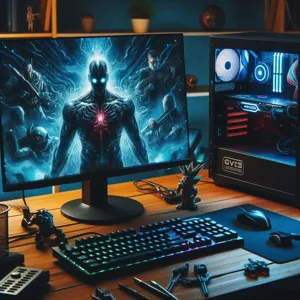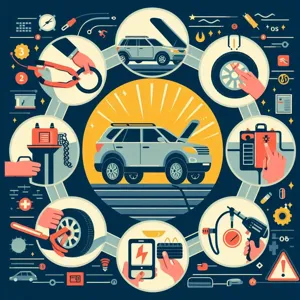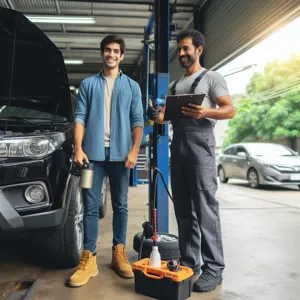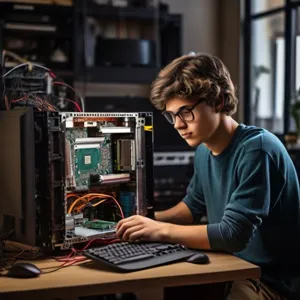For many PC gamers, few things are more frustrating than encountering the infamous Blue Screen of Death (BSOD) during an intense gaming session.
This ominous screen, often accompanied by cryptic error codes, can feel like a major roadblock, pulling you out of immersive worlds and halting your progress in a heartbeat. Whether you’re battling in the latest first-person shooter or exploring vast open worlds, the sudden appearance of the BSOD can leave you scratching your head and anxious about potential hardware failures. But fear not! In this ultimate guide, we will delve deep into the causes behind the Blue Screen of Death, equipping you with essential troubleshooting techniques to diagnose and resolve these issues effectively. From understanding common error messages to implementing preventative measures, we’ll empower you to reclaim your gaming experience and keep the action rolling. Get ready to transform your frustration into knowledge and confidence as you navigate the complexities of PC gaming!
1. Understanding the Blue Screen of Death (BSOD)

The Blue Screen of Death (BSOD) is often the most dreaded sight for any PC gamer. It’s not just a mere inconvenience; it can feel like a gut punch that pulls you out of the virtual worlds you’ve invested so much time in. But what exactly is the BSOD? At its core, the BSOD is a critical error screen that Windows displays when it encounters a serious issue that it can’t recover from. This blue screen serves as a warning that your system has run into a problem, and it needs to halt operations to prevent further damage.
When the BSOD occurs, it typically displays a message along with a stop code, which can provide crucial insights into the underlying issue. These stop codes can range from hardware failures to incompatible drivers, or even software bugs. The screen’s ominous hue isn’t just for shock value; it’s designed to grab your attention immediately, signaling that something has gone seriously awry.
Understanding the BSOD also involves recognizing its patterns. Different errors and codes can point to specific problems, such as “IRQL_NOT_LESS_OR_EQUAL” indicating memory issues, or “PAGE_FAULT_IN_NONPAGED_AREA” hinting at problems with your hard drive or RAM. By familiarizing yourself with these codes, you can begin troubleshooting more effectively, pinpointing the root cause without unnecessary guesswork.
While encountering a BSOD can be alarming, it’s important to remember that it is often a solvable problem. With a little knowledge and the right approach, you can navigate the complexities of the Blue Screen of Death, ensuring that your gaming experience remains uninterrupted and enjoyable. In the following sections, we’ll delve deeper into common causes of the BSOD and provide you with actionable solutions to get your gaming rig back in top form.
2. Common Causes of BSOD in PC Gaming
When it comes to PC gaming, few things are as frustrating as encountering the Blue Screen of Death (BSOD). This ominous screen can appear unexpectedly, abruptly interrupting your gaming session and leaving you staring at a cryptic error code. Understanding the common causes of BSOD in PC gaming is crucial for diagnosing and preventing these disruptive crashes.
One of the most prevalent culprits is hardware failure. components such as your graphics card, memory (RAM), or hard drive can fail or become incompatible, leading to system instability. Overheating is another common issue; if your PC isn’t adequately cooled, it may struggle to handle the demands of high-intensity gaming, causing it to crash.
Driver issues also play a significant role in BSOD occurrences. Outdated, corrupted, or incompatible drivers—especially graphics drivers—can interfere with your system’s ability to communicate with hardware effectively. This can happen after a Windows update or a fresh install of a game that requires different driver versions for optimal performance.
Moreover, software conflicts can lead to BSOD errors. This often occurs when multiple programs or services attempt to access the same resources simultaneously, creating a conflict that results in system crashes. Malware infections can similarly destabilize your system by corrupting files or consuming excessive resources.
Lastly, system file corruption is a common underlying issue. Critical files needed for your operating system to run smoothly may become corrupted due to improper shutdowns, hardware failures, or even power surges. This corruption can trigger BSOD errors, manifesting as various stop codes that can leave even seasoned gamers scratching their heads.
Being aware of these common causes allows you to take proactive measures to maintain system stability, ensuring that you can focus on what really matters: enjoying your gaming experience without interruption.
3. How to Identify BSOD Error Codes

Identifying Blue Screen of Death (BSOD) error codes is a crucial step in troubleshooting the issues plaguing your gaming PC. When your system succumbs to a BSOD, it displays a cryptic series of numbers and messages that might seem intimidating at first glance. However, understanding these codes can lead you directly to the root of the problem.
The BSOD typically presents a specific error code that consists of a descriptive name and a hexadecimal code. For example, you might see something like “CRITICAL_PROCESS_DIED” alongside a code such as “0x000000EF”. Each of these codes provides vital information about what went wrong with your system.
To begin identifying the error codes, take note of the message displayed on your screen. If your game crashes and the BSOD appears, grab your smartphone or a notepad to jot down the exact wording of the error. This will be your guide for further investigation.
Once you have the error message, utilize online resources, such as Microsoft’s official documentation or tech forums, to decipher its meaning. Many websites offer comprehensive lists of BSOD error codes and their potential causes. For instance, “IRQL_NOT_LESS_OR_EQUAL” often indicates issues with drivers or memory, while “PAGE_FAULT_IN_NONPAGED_AREA” might suggest a problem with your system’s RAM or hard drive.
If your BSOD doesn’t remain on-screen long enough for you to write it down, don’t worry. Windows has a built-in tool that logs these events. After a restart, you can access the Event Viewer by typing “Event Viewer” in the Windows search bar. Navigate to the “Windows Logs” section, then select “System.” Here, you can filter the events to find critical errors corresponding to the time of your BSOD.
By accurately identifying the BSOD error codes and understanding their implications, you empower yourself to take targeted actions. Whether it’s updating drivers, checking hardware, or adjusting system settings, having this knowledge at your fingertips will streamline your troubleshooting process and get you back to gaming in no time.
4. Initial Troubleshooting Steps
When confronted with the dreaded Blue Screen of Death (BSOD) during your gaming session, the first instinct may be to panic. However, staying calm and following a systematic approach can save your gaming experience and potentially preserve your hardware. Here are some initial troubleshooting steps to help you get back to your virtual adventures as swiftly as possible.
**1. Note the Error Code:** One of the first things you should do is take note of the error code displayed on the blue screen. This alphanumeric code can provide crucial information about the root cause, guiding you toward a more targeted solution. You can jot down the code or take a picture of your screen for reference.
**2. Restart Your PC:** A simple reboot can often clear transient issues that lead to a BSOD. Restart your computer and see if the problem persists. If it was a one-time glitch, you may be back to gaming in no time. However, if the BSOD reappears, it’s time to dig a little deeper.
**3. Disconnect External Devices:** Sometimes, peripheral devices such as gaming controllers, USB drives, or printers can cause conflicts that lead to system crashes. Disconnect all non-essential hardware and restart your PC. If the BSOD doesn’t occur after this, reconnect devices one at a time to identify the culprit.
**4. Boot in Safe Mode:** If the problem continues, boot your PC in Safe Mode. This starts your system with minimal drivers and services, allowing you to troubleshoot. To access Safe Mode, restart your PC and repeatedly press the F8 key (or Shift + F8 on some systems) before the Windows logo appears. From there, select “Safe Mode” from the menu.
**5. Check for Recent Changes:** Consider any changes you may have made before the BSOD began appearing. Did you install new hardware or software? If so, you might need to uninstall it or update drivers associated with those changes. Roll back any recent updates if you suspect they are the cause of the crashes.
**6. Run Diagnostics:** Most PCs come with built-in diagnostics tools that can help identify hardware issues. Access these tools through your BIOS or by using third-party software. Running a memory test can reveal if faulty RAM is to blame, while a hard drive diagnostic can check for disk errors that may be causing instability.
**7. Keep Calm and Document:** Throughout this process, it’s essential to document each step you take. Not only does this help you keep track of what you’ve tried, but it also provides valuable information if you need to seek further assistance from tech forums or customer support.
By following these initial troubleshooting steps, you’ll be well on your way to diagnosing the root cause of the BSOD. Remember, each step is a chance to learn more about your system and its quirks, so take your time and stay methodical. With patience and persistence, you’ll soon be back to conquering your favorite games.
5. Updating Graphics Drivers

Updating your graphics drivers is one of the most crucial steps in troubleshooting the infamous Blue Screen of Death (BSOD), especially for PC gamers. Graphics drivers act as the bridge between your operating system and your graphics card, ensuring that they communicate effectively to deliver stunning visuals and smooth gameplay. Outdated or corrupted drivers can lead to system instability, crashes, and, yes, those dreaded blue screens.
To begin, identify your graphics card’s manufacturer—be it NVIDIA, AMD, or Intel. Each company provides dedicated software to streamline the update process. For NVIDIA users, the GeForce Experience app is a powerful tool that not only alerts you to new driver releases but also optimizes your game settings based on your hardware specifications. AMD users can utilize the Radeon Software Adrenalin Edition for similar capabilities, while Intel provides the Intel Driver & Support Assistant for its integrated graphics solutions.
Once you have the appropriate software, the update process is typically straightforward. Launch the application and navigate to the driver update section. Here, you’ll find the latest drivers available for your hardware. Always opt for the ‘clean installation’ option when prompted; this ensures that any remnants of old drivers are removed, reducing the risk of conflicts that could lead to further BSOD issues.
In some cases, you might find that the latest driver causes more problems than it solves. If that’s the case, consider rolling back to a previous version that was stable for your system. Most of the graphics driver applications allow you to revert to earlier versions easily.
Regularly updating your graphics drivers not only enhances performance and stability but can also unlock new features and optimizations for the latest games. Keeping your drivers current is a proactive approach that can prevent many issues, including the dreaded Blue Screen of Death, allowing you to focus on what truly matters: immersive gaming experiences.
6. Checking Hardware Compatibility
When diving into the world of PC gaming, ensuring that your hardware is compatible is crucial for a smooth and enjoyable experience. The Blue Screen of Death (BSOD) can often be a result of incompatible hardware components, so it’s important to take a thorough look at each piece of equipment you plan to use.
Start by reviewing the specifications of your graphics card, RAM, and motherboard. Each of these components has specific requirements and limitations that can affect performance and stability. For instance, if your graphics card requires a certain wattage that your power supply cannot deliver, it can lead to system instability and potentially trigger a BSOD.
Next, check the RAM compatibility, as not all RAM sticks work seamlessly together. Mismatched speeds or brands can lead to conflicts that manifest as system errors. It’s also wise to consult your motherboard’s manual for the list of supported hardware, including CPU types and RAM configurations.
Additionally, look into peripheral compatibility. Sometimes, even devices such as USB drives, external hard drives, or gaming mice can cause issues if they have outdated drivers or firmware. Keeping everything updated and within the recommended specifications will significantly reduce the likelihood of encountering the dreaded blue screen.
Lastly, don’t overlook the importance of thermal management. Overheating can result in hardware failures and sudden BSODs, especially when running demanding games. Ensure your cooling system is adequate and that your components are seated properly to maintain optimal temperatures. By taking the time to verify hardware compatibility, you’ll not only prevent future blue screens but also enhance your overall gaming experience.
7. Overheating Issues and Solutions

When you’re immersed in an epic gaming session, the last thing you want is for your screen to suddenly flash that dreaded blue error message. One of the most common culprits behind this frustrating phenomenon is overheating. As your CPU and GPU work vigorously to render stunning graphics and manage complex gameplay, they generate significant heat. If your computer’s cooling system isn’t up to the task, temperatures can soar, leading to unstable performance and, ultimately, the infamous Blue Screen of Death (BSOD).
To tackle overheating issues, start with monitoring your system’s temperatures. Use software like HWMonitor or MSI Afterburner to keep an eye on your CPU and GPU temperatures during gameplay. Ideally, your CPU should not exceed 80°C, and your GPU should stay below 85°C. If you notice your components nearing these thresholds, it’s time to take action.
First, ensure that your PC’s airflow is optimal. Dust buildup in fans and vents can significantly hinder cooling performance. Regularly clean your system, focusing on the fans, heat sinks, and filters. A can of compressed air can be your best friend here, effectively blowing away dust and debris that trap heat.
Next, consider the thermal paste between your CPU/GPU and their respective coolers. Over time, thermal paste can dry out and lose its effectiveness. Reapplying high-quality thermal paste can greatly improve heat dissipation, allowing your components to run cooler and more efficiently.
upgrading your cooling solutions is another viable option. If you’re using stock coolers, consider investing in aftermarket air or liquid cooling systems that provide superior performance. High-performance fans can also enhance airflow within your case, reducing overall temperatures.
Lastly, keep your gaming environment in mind. Ensure your PC is in a well-ventilated space, away from walls or other obstructions. If possible, use a fan or air conditioning to maintain a cooler ambient temperature in the room.
By addressing overheating issues proactively, you can prevent unexpected BSODs and maintain a smooth gaming experience. Remember, a cool system is a happy system, and your gaming adventures will be much more enjoyable without the interruptions of a blue screen.
8. Running Memory and Disk Diagnostics
When it comes to diagnosing issues that may lead to the dreaded Blue Screen of Death (BSOD) while gaming, running memory and disk diagnostics can be invaluable. These tools help identify potential hardware malfunctions that could disrupt your gaming experience, leading to crashes and instability.
**Memory Diagnostics**
Your system’s RAM (Random Access Memory) plays a crucial role in performance, especially during demanding gaming sessions. If your memory is faulty, it can lead to system errors and crashes. To check for issues, you can use the built-in Windows Memory Diagnostic tool. Simply search for “Windows Memory Diagnostic” in your Start menu, select “Restart now and check for problems,” and let your PC reboot for the test. The diagnostic will run through a series of checks to identify any memory errors. If issues are found, you may need to replace or reseat the RAM sticks, or in some cases, consider a complete upgrade.
**Disk Diagnostics**
Next up is the health of your hard drive or SSD (Solid State Drive). Disk errors can also be a significant cause of BSODs, especially if your game files are located on a failing drive. Windows offers a handy built-in tool called Check Disk (CHKDSK) to scan your drives for errors. You can run this tool by opening Command Prompt as an administrator and typing `chkdsk /f`. This command will scan your drive and fix any detected issues. If you’re using an SSD, consider checking the drive’s health with specialized software like CrystalDiskInfo, which can provide a detailed overview of its status, including temperature and wear levels.
By regularly running these diagnostics, you can catch potential memory and disk issues before they escalate into more significant problems that could lead to BSODs. Moreover, maintaining your hardware’s health not only improves gaming performance but also prolongs the life of your PC. Keeping your system in top shape ensures that when you’re in the heat of battle, the only thing you’ll have to worry about is defeating your opponents—not losing your progress to a crash.
9. Verifying Game Files and Game Settings
When you encounter the dreaded Blue Screen of Death (BSOD) while indulging in your favorite PC games, it can be a frustrating experience. One step that often gets overlooked but can be pivotal in resolving these issues is verifying your game files and adjusting your game settings. This process ensures that your game is running as intended and not plagued by corrupted files or misconfigured settings.
To begin, most gaming platforms, such as Steam, Epic Games, or Origin, offer built-in tools that allow you to easily verify the integrity of your game files. This feature scans your game installation for any missing or corrupted assets and replaces them automatically. For instance, on Steam, simply right-click the game in your library, select Properties, navigate to the Local Files tab, and click on “Verify Integrity of Game Files.” This action can resolve crashes caused by missing textures, broken scripts, or corrupted saves, all of which can contribute to the BSOD during gameplay.
After ensuring that your game files are intact, it’s crucial to review your game settings. Sometimes, the default settings may not be optimized for your hardware, leading to instability. Check the graphics settings, resolution, and frame rate limits. If you’re running a high-performance game on a mid-range system, overly ambitious settings might push your hardware beyond its limits, triggering crashes. Lowering the graphics quality or disabling demanding features like anti-aliasing or V-Sync can significantly enhance stability.
Additionally, ensure that your game is updated to the latest version, as developers frequently release patches that fix bugs and improve performance. Pair this with running the game in compatibility mode if you’re using an older title on a newer operating system. By systematically verifying your game files and carefully adjusting your settings, you can minimize the risk of encountering the BSOD, allowing you to immerse yourself fully in your gaming adventures without interruptions.
10. Reinstalling Problematic Games
When all else fails and the dreaded Blue Screen of Death (BSOD) continues to plague your gaming experience, it may be time to consider reinstalling the problematic games. Although it might seem like a drastic measure, this step can often resolve underlying issues that other troubleshooting methods haven’t addressed.
Before you dive in, it’s crucial to identify which game or games are causing the BSOD. Take note of any error messages or patterns occurring when these games are launched. Whether it’s a specific title or a series of games, understanding the root of the problem will help streamline your reinstallation process.
To begin, ensure that you back up your saved files, mods, and custom settings. Many modern games have built-in cloud saves or allow you to manually back up your game data, so utilize these features to avoid losing hours of progress. Once your files are secure, you can proceed with the uninstallation process. This can typically be done through your game client (like Steam, Epic Games, or Origin) or the Windows Control Panel. Remove the game completely, ensuring all associated files and folders are deleted to eliminate any corrupted data.
After a clean uninstallation, reboot your PC. This step helps clear any residual files that may interfere with the new installation. Next, navigate to your game client or download platform and reinstall the game. Make sure to download the latest patches and updates, as game developers frequently release fixes that can resolve compatibility issues that might lead to BSOD errors.
Once the installation is complete, launch the game to see if the problem persists. If the BSOD continues to rear its ugly head, it may indicate deeper issues within your system, such as driver conflicts or hardware malfunctions. However, if the game runs smoothly, you’ve successfully eliminated the issue and can now dive back into your gaming world, free from interruptions. Reinstalling problematic games can be a simple yet effective solution in the broader troubleshooting process, allowing you to enjoy your favorite titles without the fear of sudden crashes.
11. System Restore and Recovery Options
When all else fails in the battle against the dreaded Blue Screen of Death (BSOD), system restoration and recovery options can be your saving grace. These powerful tools are designed to help you revert your system to a previous state, effectively undoing any recent changes that may have led to the dreaded crashes during your gaming sessions.
To begin, navigate to your Windows settings and locate the “System” tab. From here, select “System Protection” to access the System Restore feature. This tool allows you to roll back your operating system to a point in time before the issues began, without affecting your personal files. You’ll see a list of restore points—these are snapshots of your system taken automatically or manually at various times. Choose a point that predates the BSOD occurrences, and follow the prompts to initiate the restore. This process will require a restart and may take several minutes, but it can often eliminate the underlying problems that caused the BSOD in the first place.
In cases where System Restore doesn’t resolve the issue, you might need to explore the recovery options available through Windows Recovery Environment (WinRE). You can access WinRE by restarting your PC and repeatedly pressing the F8 or Shift + F8 key during boot-up (the exact key may vary depending on your system). Once inside, you’ll be presented with several recovery options, including Startup Repair, which can fix issues that prevent Windows from loading correctly, and Reset this PC, which allows you to keep or remove your personal files while reinstalling Windows.
Remember, before proceeding with any recovery options, back up any important data whenever possible. While these tools are designed to fix problems, they can sometimes lead to data loss, especially if you choose to reset your PC. By understanding and effectively utilizing System Restore and recovery options, you can reclaim your gaming experience and minimize downtime caused by the Blue Screen of Death.
12. Windows Updates: Importance and Impact
When it comes to troubleshooting the infamous Blue Screen of Death (BSOD) in PC gaming, one of the most crucial aspects to consider is the role of Windows updates. These updates are not just a routine annoyance; they play a vital role in maintaining the stability, performance, and security of your operating system. An outdated version of Windows can lead to compatibility issues, driver malfunctions, and even critical system failures that may result in the dreaded blue screen.
Windows updates often include important patches and fixes for known bugs, which can directly impact your gaming experience. For instance, a recent update might resolve a compatibility issue with the latest game title or improve the performance of your graphics card. Conversely, failing to install these updates can leave your system vulnerable to errors that could trigger BSOD crashes.
Moreover, Windows updates can introduce new features and enhancements that improve your gaming setup, such as DirectX updates, which can significantly enhance graphics performance and visual fidelity in games. Regularly checking for updates and ensuring that your system is running the latest version of Windows can help mitigate potential BSOD issues before they arise.
It’s also worth noting that while updates are essential, they can occasionally introduce their own set of problems. Some users have experienced new crashes or performance drops after a major update. In such cases, it’s important to stay informed about known issues related to specific updates and be prepared to roll back to a previous version if necessary. Keeping a close eye on Windows updates and understanding their importance can go a long way toward ensuring a smooth and enjoyable gaming experience, free from the interruptions of the Blue Screen of Death.
13. Advanced Troubleshooting Techniques
When faced with the dreaded Blue Screen of Death (BSOD) while gaming, it can feel like your PC has betrayed you at the most inconvenient moment. However, before you throw in the towel, it’s time to delve into advanced troubleshooting techniques that can help identify and resolve the underlying issues causing these crashes.
**1. Analyze the Dump Files:**
One of the first steps in advanced troubleshooting is to analyze the memory dump files created at the time of the BSOD. These files contain crucial information about what your system was doing when the crash occurred. You can use software like BlueScreenView or WinDbg to read these files. Look for patterns or recurring error messages, as they can provide insights into faulty drivers or hardware.
**2. Driver Verifier:**
Windows comes equipped with a tool known as Driver Verifier, designed to stress test your drivers and identify problematic ones. Enabling Driver Verifier can help you pinpoint which driver is causing the BSOD. Navigate to the Command Prompt as an administrator and type `verifier`. Follow the prompts to select the drivers you want to verify. Be cautious with this tool, as it may lead to additional crashes, but it can be invaluable for diagnosis.
**3. Hardware Diagnostics:**
Sometimes, the BSOD can be attributed to hardware failures, such as failing RAM or overheating components. Utilize built-in tools like Windows Memory Diagnostic to check for RAM issues or third-party software like HWMonitor to monitor your system’s temperatures. If you suspect a hardware component, consider running a stress test using tools like Prime95 for the CPU or MemTest86 for RAM to uncover faults that may not be immediately apparent.
**4. Clean Boot:**
Performing a clean boot can help isolate software conflicts that might be causing the BSOD. This process involves starting Windows with a minimal set of drivers and startup programs. By doing so, you can determine if background applications or services are contributing to the problem. To initiate a clean boot, type `msconfig` in the Run dialog (Windows + R) and adjust the settings under the ‘Services’ and ‘Startup’ tabs.
**5. Update BIOS and Firmware:**
In some cases, outdated BIOS or firmware can lead to compatibility issues, particularly with newer hardware or software. Check the manufacturer’s website for your motherboard or system to see if there are any updates available. Updating the BIOS can be a complex process, so be sure to follow the instructions carefully to avoid further complications.
By systematically applying these advanced troubleshooting techniques, you can significantly improve your chances of resolving the Blue Screen of Death and get back to enjoying your gaming experience. While these steps may require a bit more technical skill and patience, they can save you from future frustrations and ensure your system runs smoothly. Remember, every BSOD is an opportunity to learn more about your PC and its inner workings!
14. When to Seek Professional Help
In the world of PC gaming, the Blue Screen of Death (BSOD) can feel like a dark cloud hovering over your gaming experience, ready to strike at any moment. While many issues can be resolved with a little troubleshooting or by following DIY guides, there comes a time when you might need to recognize your limitations and seek professional help. Understanding when to make that call can save you not only time but also the potential for further damage to your system.
If you’ve diligently followed troubleshooting steps—updating drivers, checking for hardware issues, running diagnostics, and even reinstalling the operating system—yet the BSOD continues to rear its ugly head, it may indicate deeper, more complex problems. Persistent crashes could signal hardware failures, such as a failing hard drive, overheating components, or faulty RAM, which are often difficult to diagnose without specialized tools and expertise.
Additionally, if you’re encountering specific error codes that keep recurring, and online forums or tech articles are not providing clear solutions, it’s time to consider professional assistance. Experts have the experience and tools necessary to accurately assess and address the root cause of these errors, often spotting issues that an average user might overlook.
Moreover, if your gaming setup is critical for your livelihood—whether you’re a content creator, streamer, or professional gamer—delaying repairs due to uncertainty can lead to lost income and missed opportunities. In such cases, investing in professional help is not just advisable; it’s a necessity.
While it’s empowering to handle issues independently, knowing when to seek professional help ensures that your gaming rig remains in top condition, ready to deliver the seamless gaming experiences you crave. Don’t hesitate to reach out—whether to a trusted technician, a local repair shop, or even the customer support line of your hardware manufacturer. Your gaming journey deserves the best care possible to keep the BSOD at bay.
15. Preventive Measures for Future BSOD Issues
The Blue Screen of Death (BSOD) can be a frustrating setback for any PC gamer, but understanding how to prevent future occurrences can save you from repeated disruptions during your gaming sessions. Here are some essential preventive measures to keep your system running smoothly and minimize the chances of encountering BSOD issues in the future.
**1. Keep Your System Updated:** Regularly updating your operating system, drivers, and firmware is crucial. These updates often include important patches that fix security vulnerabilities and improve system stability. Make a habit of checking for updates frequently, especially after major game releases or hardware upgrades.
**2. Monitor Hardware Health:** Overheating components can lead to instability and crashes. Invest in monitoring software that tracks the temperature of your CPU, GPU, and other critical hardware. Ensure that your cooling systems—fans and heatsinks—are clean and functioning correctly. Additionally, consider running stress tests to detect any potential hardware issues before they lead to BSOD.
**3. Regular System maintenance:** Performing routine maintenance can help prevent software-related BSOD issues. This includes disk cleanup to remove unnecessary files, defragmenting your hard drive (for HDDs), and checking for file system errors using built-in tools like CHKDSK. A well-maintained system is less likely to encounter critical errors.
**4. Use Reliable Power Sources:** Sudden power surges or outages can lead to system instability and BSOD. Make sure your gaming setup is connected to a reliable power source, preferably with an uninterruptible power supply (UPS) that can protect against fluctuations and allow for a safe shutdown during power loss.
**5. Be Cautious with Software Installations:** Installing incompatible or poorly designed software can lead to conflicts that result in BSOD. Always research applications and mods before installation, particularly those related to gaming. Stick to reputable sources and check user reviews for compatibility with your system.
**6. Scan for Malware:** Malware infections can cause significant instability in your system. Regularly scan your computer with trusted antivirus software to detect and eliminate threats. A clean system not only performs better but is also less prone to crashes.
**7. Back-Up Data Regularly:** While this may not prevent BSOD, having a robust backup strategy ensures that you won’t lose your progress in games or important files if a crash occurs. Use cloud services or external drives to keep your data safe.
By implementing these preventive measures, you can significantly reduce the likelihood of encountering the dreaded Blue Screen of Death in your gaming experience. Remember, a well-maintained system not only enhances performance but also provides you with the peace of mind needed to fully enjoy your gaming adventures without interruption.
In conclusion, navigating the challenges of the Blue Screen of Death can be daunting, especially for passionate PC gamers eager to dive back into their favorite virtual worlds. Our ultimate guide has equipped you with essential troubleshooting steps, from identifying hardware conflicts to updating drivers and optimizing system settings. Remember, patience and methodical problem-solving are key when addressing these technical hiccups. With the knowledge you’ve gained, you’ll be well-prepared to tackle any BSOD situation that arises, ensuring a smoother and more enjoyable gaming experience. Now, armed with these insights, it’s time to get back in the game—may your adventures be uninterrupted and your victories plentiful! Happy gaming!



































